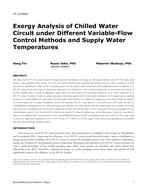-
-
Available Formats
- Options
- Availability
- Priced From ( in USD )
-
Available Formats
-
- Immediate download
-
$16.00Members pay $7.00
- Add to Cart
Customers Who Bought This Also Bought
-

AT-15-C043 -- Diffuser Selection for All-Air Heating Syst...
Priced From $16.00 -

AT-15-C044 -- Novel Frost-Handling Techniques Using Air-B...
Priced From $16.00 -

AT-15-C005 -- Exergy Analysis of Chilled-Water Circuit un...
Priced From $16.00 -

AT-15-C027 -- Heat Transfer and Pressure Drop of New LGWP...
Priced From $16.00
About This Item
Full Description
This paper describes the monitoring activity performed during the summer of 2014 in an energy-efficient elderly nursing home in Northern Italy. The ASHRAE Performance Measurement Protocol was used as a reference protocol to perform this energy audit. Moreover, the data from the monitoring activity, including thermal comfort and air quality levels, allowed the facility manager to correspondingly decrease the energy consumption. For example, the energy demand for chilled and hot water pumping was decreased by about 10%-15% just by modifying the related availability schedules for secondary loop pumps (e.g., turning pumps off at appropriate times). Assumptions and boundary conditions used to size HVAC systems, as well as to perform energy audits, usually come from rough approximations or statistical generalizations and may differ significantly from the ones taking place in actual operation. This could lead to actual building energy bills that are far from the ones taken into account in terms of economic feasibility evaluations, with consequent differences in the real pay-back time. In order to assess the statistical accuracy of building energy consumption forecasts as well as to collect usage profiles for energy audits closer to the actual operating conditions, monitoring HVAC systems is crucial. Of course, this activity can also be used to test new control strategies in actual operation as well as to identify off-normal operating events or evaluate possible HVAC system oversizing. The present paper shows the importance of a standardized monitoring activity, also in new buildings, which when combined with careful tuning leads to further energy reductions over the ones predicted in the design phase.





